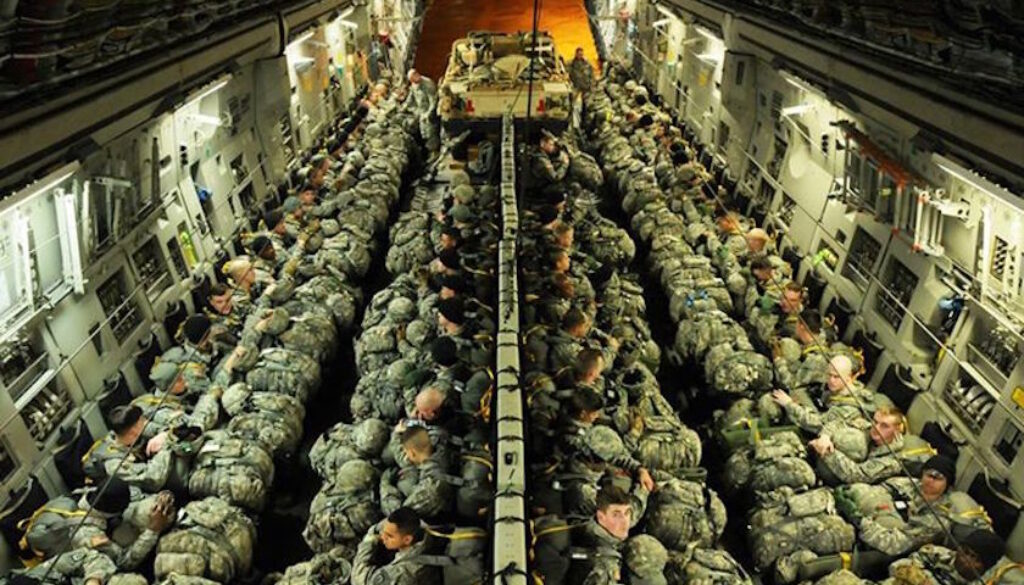Parachutes, part 1: The Jump
The U.S. Army is very, very good at launching large numbers of parachutists from airplanes. Dozens, scores, hundreds of soldiers at a time, every jumper equipped with reliable gear, every jumper prepared with comprehensive, rigorous training, supervised by jumpmasters who have spent more time airborne — in and out of airplanes — than many people have spent walking, and backed by a system that has been supplying, organizing, practicing, and executing jumps for so long, and in so many places and circumstances (including, yes, many where the gravity-associated hazards are relatively trivial), that every conceivable variable, every possible hazard, failure mode, catastrophe, and malfunction, every likely and unlikely combination of recalcitrant equipment and human folly has long ago been recognized, taken into account, and given a place in the manual. Well, there are always exceptions. This is the story of one.
In order to stay qualified, every Airborne member must make a “proficiency jump” at least once every 90 days. Some units and specialties might require more frequent jumps to maintain qualification. For this exercise there were 100 soldiers aboard a C-17 Globemaster 3. Half were seated on either side of the fuselage, with a Humvee in the middle, right aft. The idea was to put the ramp door down on the first pass over the target, launch the vehicle, and then circle around and launch the personnel. The vehicle was to go out first for reasons that might be obvious once you think about it. Not obvious? Just imagine yourself on the ground after a bad landing. You’ve broken your leg, and aren’t moving real well. The last thing you need is a 5-ton truck floating down onto you. This is the kind of thing the manual helps with. The difficulties with this particular exercise started with a glitch in the ramp mechanism, preventing the Humvee drop.
To appreciate what happened next, it would be useful to know a bit about the logistics of mass jumps. Every soldier’s primary chute has a static line that runs from the pack, then up and over the inboard shoulder. That way it won’t be under an arm or around your neck when you turn outboard at the door to jump. The tether terminates in a robust clip. For walking around before the jump, the clip is secured to a gear loop on the soldier’s chest. The chute is held in place by cotton webbing with an 80 lb. break strength. When the paratrooper leaves the plane and fetches up at the end of the static line, the force tears out the cotton webbing, and the chute deploys. It’s a brutally simple, wonderfully reliable arrangement, but it can be compromised. For instance, it is possible for the rigger to use a stronger webbing than the 80 lb. cotton (the penalties for this are understandably severe).
It is also possible for a jumper somehow to misreeve or tangle the static line before a jump, getting it stuck behind a D-ring, strap, or the like. If this happens the static line might not tear the webbing out, and the jumper can end up hanging on the outside of the plane, slamming repeatedly and violently against the fuselage in the slipstream. But there’s a procedure for this, too: if the jumper is still conscious and uninjured (and you can tell because, as per training for this unlikely eventuality, they’ll be curled up in a ball, with no limp limbs), then the jumpmaster will just cut the static line. That’s what reserve chutes are for. If the jumper is unconscious or significantly injured, the jumpmaster will arrange to haul the person back inboard, then proceed with getting the rest of the people out. This is yet another of the many screwups that the system is prepared to deal with.
There are four jumpmasters, two at each exit door. One on each side is there to assist with the static lines, and to act as a safety. When it is time to jump, the jumpmasters check with the aircrew, and then begin giving a very specific series of commands. First is the order to stand up, then to hook up. On the latter command, everyone in the “stick” (line of jumpers) transfers their hook to a taut overhead cable that runs fore-and-aft, just inboard of the seats, on both sides of the plane (on really packed flights, as in the picture above, there are two inboard rows of seats). Then comes the command to check static lines. Next is the command to check all equipment. The jumpmasters already gave everyone a thorough inspection before the plane boarded, but in the next couple of minutes everyone is going to jump out of an airplane. So everyone checks again. They check the helmets’ chin straps, the parachutes’ leg and chest straps, any and all gear straps and lanyards. They check the up to 70 lbs(!) of gear they will be jumping with. And everyone pays particular attention to those static lines: You check your own static line in front of you, where you can see it, and you check the static line on the back of jumper ahead of you. It absolutely must run fair. When all is checked, the jumpmasters call out “Sound off for equipment check.” The forwardmost jumpers (they’ll be the last ones off), call out “OK,” and tap the back of the person in front of them. On receiving that signal, that person calls “OK,” then taps the next person, and so on. The idea is that every jumper in both sticks confirms readiness. When the person at the front of the line feels that tap, they call out “OK jumpmaster,” and holds a “knife hand” (fingers straight, thumb laid down flush, palm vertical) pointed right up in front of the jumpmaster’s face. Even this specific hand ritual speaks of deep institutional experience; these airplanes are noisy things, and lighting is not always ideal. There is no room for ambiguity or uncertainty, thus the string of verbal as well as physical signals along the length of the stick. But the lead jumper, instead of tapping the jumpmaster, emphatically extends a hand, formed to maximize visibility and minimize getting a sprained finger from what comes next: the jumpmaster makes an emphatic verbal acknowledgement, and then slaps the hand to make an equally emphatic physical acknowledgement.
Now the loadmasters — specialized Air Force crewmembers — raise the doors, latch them open, and let the cockpit crew know that all is ready, at which point the pilot will radio, “Army, your door.”
The jumpmasters conduct a careful ritual, checking the edges around the door for sharp spots. It wouldn’t do to have a static line get severed when it fetches up. With the door done, the jumpmaster on each side leans right out of the door and looks around, making sure that no other aircraft are in dangerous proximity, and not incidentally looking to see that they are not over the wrong target. It happens.
Up until now there has been a red “jump light” glowing in the cabin. At 30 seconds from go, an amber light replaces the red, the jumpmaster calls out “stand by,” and the first jumper turns to face out the door.
Finally a green light comes on and the jumpmaster says “green light go,” smacks the first jumper on the leg or butt, and the jump commences. A soldier goes out on one side of the plane, followed by a soldier from the other side. The two lines shuffle aft, jumpers leaving alternate sides of the plane at half-second intervals. That’s right, half-second intervals; the idea is to get an effective group on the ground as quickly as possible. To help keep the intervals from being too tight, no one moves towards the door until the person ahead of them is a full arm’s length away. Every mass jump that the army conducts sees each of these details — and more that we don’t have space for here — done consistently and scrupulously. Every step puts the jumpers that much further from potential catastrophe.
With all this in mind, let’s return to our plane with the jammed tail ramp. This is an extremely uncommon mechanical failure, because aircraft mechanics tend to be at least as thorough and skillful as parachutists, but sometimes things do break. The jumpmasters confer briefly and decide to scrub that part of the mission and move on to the next. As covered in the manual. People start going out the doors.
The soldier who related this story to me (we’ll call him George) was 3rd in line on his side of the plane, so he was to be the 5th or 6th one out. A lieutenant he worked with (we’ll call her Maria), was on his side. Second in line on the other side was another lieutenant (we’ll call him Bill). Unfortunately, what should have been a routine jump was unbalanced by the unanticipated presence of the Humvee, which partially blocked the view between the two doors. The lines started out not-quite-synchronized, and Maria and Bill went out their respective doors almost simultaneously.
The slipstream of the plane swept both soldiers aft and inboard, canopies already deploying. In some cases when this happens, bodies will collide hard enough to knock one or both parties out. Bad. In this case the collision wasn’t too serious, but the two partially-deployed chutes immediately tangled and collapsed. The two soldiers were now locked together, heading for the ground at speed, and accelerating.
Next week: The Landing
Note: the names of the people in this story have been changed to protect privacy, and to respect an insistent humility.
Enjoy the story? Looking for more? You’re in luck! “Falling,” which in includes this and other tales from aloft, both thrilling and amusing, is now for sale on Amazon.com in handy e-book form! Or click here to get it on Apple iBooks!
From dropped tools to collapsed towers to near-fatal falls, the litany of accidents and near-accidents is long… and the sometimes miraculous outcomes are both instructive and thought-provoking.
Not a technical manual, “Falling” is nonetheless a must-have companion in the library of anyone working at heights.



February 16, 2018 @ 9:11 am
What a cliffhanger!